论文摘要 英文范本
论文摘要的英文翻译
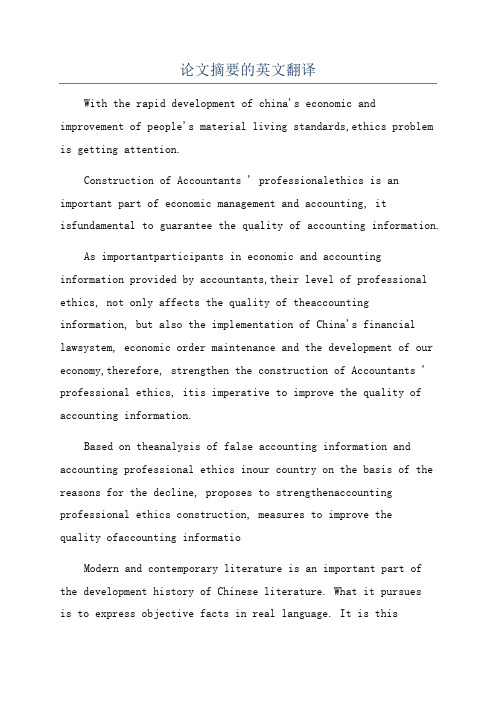
论文摘要的英文翻译With the rapid development of china's economic and improvement of people's material living standards,ethics problem is getting attention.Construction of Accountants ' professionalethics is an important part of economic management and accounting, it isfundamental to guarantee the quality of accounting information.As importantparticipants in economic and accounting information provided by accountants,their level of professional ethics, not only affects the quality of theaccounting information, but also the implementation of China's financial lawsystem, economic order maintenance and the development of our economy,therefore, strengthen the construction of Accountants ' professional ethics, itis imperative to improve the quality of accounting information.Based on theanalysis of false accounting information and accounting professional ethics inour country on the basis of the reasons for the decline, proposes to strengthenaccounting professional ethics construction, measures to improve thequality ofaccounting informatioModern and contemporary literature is an important part of the development history of Chinese literature. What it pursuesis to express objective facts in real language. It is thisauthenticity of modern and contemporary literature that makes it have an impact that can not be ignored on the structure of works in the whole literary circle.Feminist translation theory, as a major school oftranslation theory, pays attention to gender differences in translation and changes the traditional male dominated gender subject consciousness in literary translation. Feminist translation theory takes women as the metaphor of translation, advocates re examining social culture from a female perspective in translation, and pays attention to highlighting female subject identity and female consciousness in translation works.Moreover, feminist translation theory also gives us a lot of enlightenment. For example, in the process of translation, we should grasp the real value of women, link the text with the corresponding social, historical and cultural and related texts, and pay attention to the internal relationship between the translator and the author, works and readers in literary translation, so as to make their works more image Accurate and vivid, more highly reflect its literary level and value.。
论文英文摘要翻译浅析(优秀3篇)
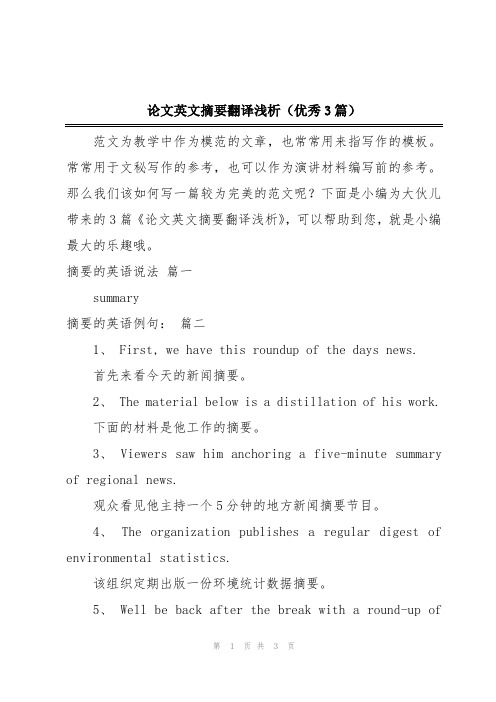
论文英文摘要翻译浅析(优秀3篇)范文为教学中作为模范的文章,也常常用来指写作的模板。
常常用于文秘写作的参考,也可以作为演讲材料编写前的参考。
那么我们该如何写一篇较为完美的范文呢?下面是小编为大伙儿带来的3篇《论文英文摘要翻译浅析》,可以帮助到您,就是小编最大的乐趣哦。
摘要的英语说法篇一summary摘要的英语例句:篇二1、 First, we have this roundup of the days news.首先来看今天的新闻摘要。
2、 The material below is a distillation of his work.下面的材料是他工作的摘要。
3、 Viewers saw him anchoring a five-minute summary of regional news.观众看见他主持一个5分钟的地方新闻摘要节目。
4、The organization publishes a regular digest of environmental statistics.该组织定期出版一份环境统计数据摘要。
5、 Well be back after the break with a round-up oftodays other stories.休息之后我们会摘要报道今天其他的新闻。
6、 Later we received resumes of what she had said.后来我们收到她讲话的摘要。
7、Objective Inquiry into the heavy asphy_iation rescues measure of the new born.摘要目的探讨新生儿重度窒息抢救的措施。
8、 He has abstracted the speech.他对讲话作了摘要。
9、 He made an abstract of a long article.他对一篇长文章做了摘要。
如何撰写毕业论文的英文摘要与关键词
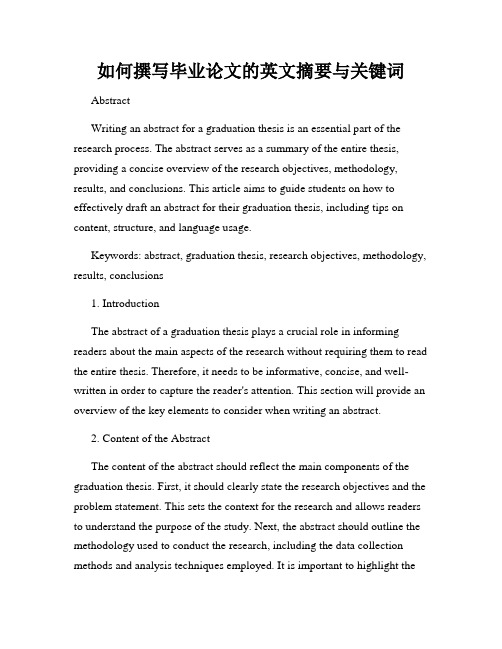
如何撰写毕业论文的英文摘要与关键词AbstractWriting an abstract for a graduation thesis is an essential part of the research process. The abstract serves as a summary of the entire thesis, providing a concise overview of the research objectives, methodology, results, and conclusions. This article aims to guide students on how to effectively draft an abstract for their graduation thesis, including tips on content, structure, and language usage.Keywords: abstract, graduation thesis, research objectives, methodology, results, conclusions1. IntroductionThe abstract of a graduation thesis plays a crucial role in informing readers about the main aspects of the research without requiring them to read the entire thesis. Therefore, it needs to be informative, concise, and well-written in order to capture the reader's attention. This section will provide an overview of the key elements to consider when writing an abstract.2. Content of the AbstractThe content of the abstract should reflect the main components of the graduation thesis. First, it should clearly state the research objectives and the problem statement. This sets the context for the research and allows readers to understand the purpose of the study. Next, the abstract should outline the methodology used to conduct the research, including the data collection methods and analysis techniques employed. It is important to highlight thekey findings and results obtained from the research, showcasing the significance and implications of the study. Finally, the abstract should summarize the main conclusions drawn from the research, highlighting any recommendations or further areas of study.3. Structure of the AbstractTo ensure clarity and coherence, the abstract should follow a specific structure. It is recommended to use the following format: introduction, method, results, and conclusion. This structure allows readers to easily navigate the abstract and understand the main aspects of the research. Each section within the abstract should be concise, yet provide enough information to convey the main ideas effectively.4. Language UsageWhen writing the abstract, it is important to use clear and concise language. Avoid using jargon or technical terms that may not be familiar to all readers. Instead, use plain language to ensure that the abstract can be understood by a wide range of audiences. Additionally, focus on using active voice and avoid excessive use of passive voice to enhance the readability of the abstract. Lastly, proofread the abstract carefully to avoid any grammatical or spelling errors that could hinder the overall clarity of the text.5. Length of the AbstractThe length of the abstract may vary depending on the requirements set by the educational institution or the journal publishing guidelines. However, as a general guideline, the abstract should not exceed 250-300 words. It is important to be concise and selective in the information provided, focusingonly on the key aspects of the research. Remember that the abstract acts as a summary and should not include excessive details or citations.6. Finalizing the AbstractOnce the abstract is drafted, it is essential to review and revise it to ensure accuracy and coherence. Seek feedback from advisors, professors, or peers to gather different perspectives and improve the quality of the abstract. Ensure that the abstract aligns with the content of the graduation thesis and accurately reflects the research conducted. Additionally, double-check the formatting and style requirements to ensure compliance with the specific guidelines provided.In conclusion, writing an abstract for a graduation thesis requires careful consideration of the content, structure, and language usage. The abstract should provide a concise summary of the research objectives, methodology, results, and conclusions. By following the guidelines outlined in this article, students can effectively draft an abstract that captures the essence of their research and engages the readers.Keywords: abstract, graduation thesis, research objectives, methodology, results, conclusions。
论文写作中的英文摘要范例
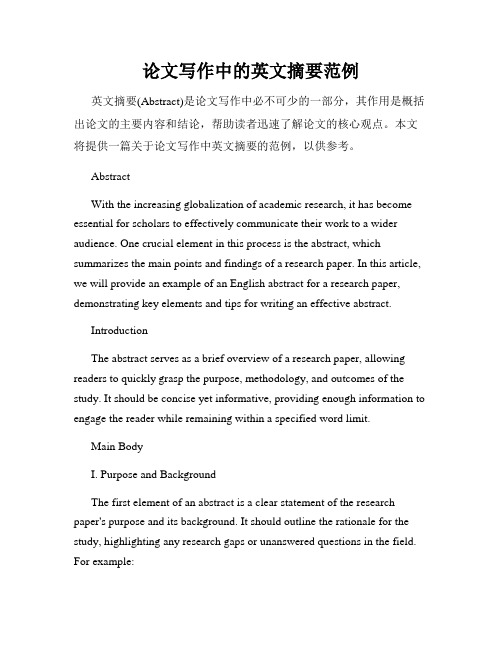
论文写作中的英文摘要范例英文摘要(Abstract)是论文写作中必不可少的一部分,其作用是概括出论文的主要内容和结论,帮助读者迅速了解论文的核心观点。
本文将提供一篇关于论文写作中英文摘要的范例,以供参考。
AbstractWith the increasing globalization of academic research, it has become essential for scholars to effectively communicate their work to a wider audience. One crucial element in this process is the abstract, which summarizes the main points and findings of a research paper. In this article, we will provide an example of an English abstract for a research paper, demonstrating key elements and tips for writing an effective abstract.IntroductionThe abstract serves as a brief overview of a research paper, allowing readers to quickly grasp the purpose, methodology, and outcomes of the study. It should be concise yet informative, providing enough information to engage the reader while remaining within a specified word limit.Main BodyI. Purpose and BackgroundThe first element of an abstract is a clear statement of the research paper's purpose and its background. It should outline the rationale for the study, highlighting any research gaps or unanswered questions in the field. For example:This research aims to investigate the effects of climate change on coastal ecosystems, with a focus on marine biodiversity and coral reef health. Given the increasing threats to these ecosystems, understanding the potential impacts of climate change is crucial for effective conservation strategies.II. MethodologyThe abstract should briefly describe the methodology employed in the research. This can include the study design, data collection methods, and analytical approaches. However, detailed technical information should be avoided. For example:A combination of field surveys, laboratory experiments, and statistical analyses were conducted to assess the long-term effects of temperature increase and ocean acidification on coral reefs. Data on species diversity, abundance, and health were collected from various reefs in the Caribbean region.III. ResultsThe abstract should highlight the key findings of the research. It should summarize the outcomes and conclusions derived from the data analysis. However, specific data or numerical results should be avoided, focusing instead on general trends and significant discoveries. For example:Our study revealed a significant decline in coral species diversity and overall health in response to increased water temperatures and ocean acidification. Furthermore, we found a decrease in the abundance of commercially important fish species, indicating potential impacts on local communities dependent on coral reef resources.IV. Implications and ConclusionThe abstract should conclude with a discussion of the broader implications of the research and its significance. It should provide a concise statement summarizing the main contributions of the study to the field and any recommendations for future research or policy implications. For example:These findings highlight the urgent need for immediate actions to mitigate the effects of climate change on coastal ecosystems. Implementing measures to reduce greenhouse gas emissions and establishing marine protected areas can help safeguard marine biodiversity and protect the livelihoods of communities dependent on coral reef resources.ConclusionIn conclusion, writing an effective English abstract is crucial for communicating the key points and contributions of a research paper. By providing a clear purpose, concise methodology, major findings, and broader implications, the abstract serves as a concise summary of the research work, enticing readers to delve deeper into the full paper. By following the guidelines and structure provided in this example abstract, researchers can enhance their chances of effectively conveying their research to a global audience.。
摘要用中文翻译成英文
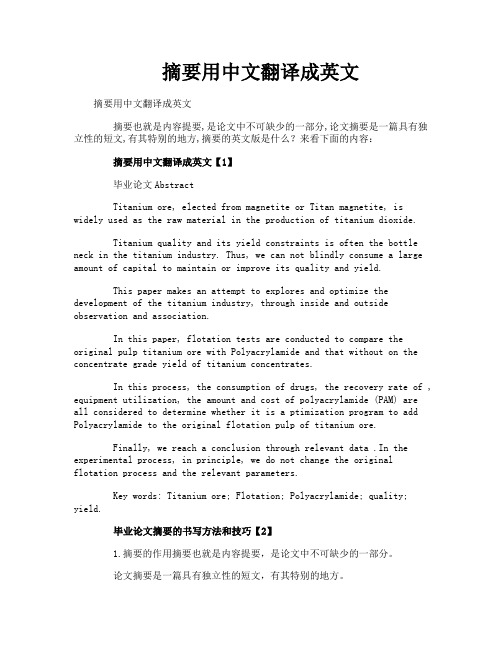
摘要用中文翻译成英文摘要用中文翻译成英文摘要也就是内容提要,是论文中不可缺少的一部分,论文摘要是一篇具有独立性的短文,有其特别的地方,摘要的英文版是什么?来看下面的内容:摘要用中文翻译成英文【1】毕业论文AbstractTitanium ore, elected from magnetite or Titan magnetite, is widely used as the raw material in the production of titanium dioxide.Titanium quality and its yield constraints is often the bottle neck in the titanium industry. Thus, we can not blindly consume a large amount of capital to maintain or improve its quality and yield.This paper makes an attempt to explores and optimize the development of the titanium industry, through inside and outside observation and association.In this paper, flotation tests are conducted to compare the original pulp titanium ore with Polyacrylamide and that without on the concentrate grade yield of titanium concentrates.In this process, the consumption of drugs, the recovery rate of , equipment utilization, the amount and cost of polyacrylamide (PAM) areall considered to determine whether it is a ptimization program to add Polyacrylamide to the original flotation pulp of titanium ore.Finally, we reach a conclusion through relevant data .In the experimental process, in principle, we do not change the originalflotation process and the relevant parameters.Key words: Titanium ore; Flotation; Polyacrylamide; quality; yield.毕业论文摘要的书写方法和技巧【2】1.摘要的作用摘要也就是内容提要,是论文中不可缺少的一部分。
学术论文英文摘要模板

学术论文英文摘要模板AbstractSince Dewey developed the concept of “critical thinking”, many scholars abroadhave carried out a series of studies about improving students' critical thinking skills ineducation field. In the 1980s,critical thinking became the target of higher educationprograms in such foreign countries as the US and Canada. It has gained its widespreadattention in China only in recent years. But there are only few studies about it ineducation field. Our traditional English teaching method pays much attention to thetraining of students' linguistic knowledge and language skills but ignores thecultivation of students' critical thinking abilities. In the process of skill practice,teachers often stress the importance of memorizing vocabulary and imitating skillsrigidly,but neglect the students' abilities in analyzing problems and putting forwardinnovative solutions. Therefore, English writing teaching is affected by this andmerely attaches emphasis to train students' reading and writing skills. There are fewstudies which aim at systematically cultivating students' analysis, synthesis, summary,comparison and reasoning skills while they are writing. Therefore,this study aims atdesigning some writingstasks and teaching strategies which can be used to fostercollege students' critical thinking awareness and promote students' all-rounddevelopment.According to six critical thinking skills,this study was carried out by requiringstudents to hand in an argumentation. All participants in this study are non-Englishmajor college freshmen from a 211 key university. The revised version of Rubric forQualitative Critical Thinking Skills Instrument was used in this study. Withquantitative and qualitative analysis,writing experiment is conducted within a wholesemester to collect data concerning students' learning behavior. Reading-to-write isused in experimental class while traditional method is adopted in control class. Thewriting scores by the experimental and control class were statistically processed bysoftware SPSS 19.0. And also the interview was launched in some of students inexperimental class to assess students' critical thinking abilities reflected in theirwritings-The final analysis indicated that EGAP writing model exerted a significantlypositive influence in improving students' critical thinking skills, especially in arousingstudents' writing enthusiasm and critical thinking awareness. Compared with controlclass, students in experimental class made bigprogress in writing competence. Inaddition, this study put forward some reform proposals to the teaching of Englishwriting. The study is of great value to instruct students to employ critical thinkingskills in their writing.AbstractA large body of research has been conducted on the effects of technology-enhancedEnglish vocabulary learning since the 1960s (Marty, 1981)。
论文英文摘要 (1)
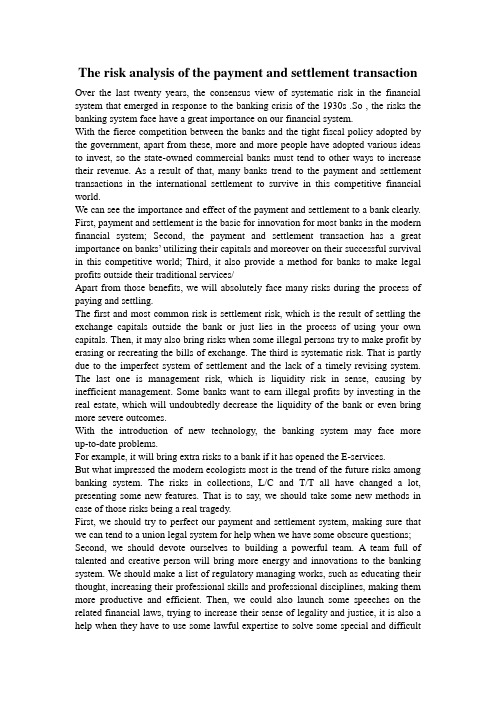
The risk analysis of the payment and settlement transaction Over the last twenty years, the consensus view of systematic risk in the financial system that emerged in response to the banking crisis of the 1930s .So , the risks the banking system face have a great importance on our financial system.With the fierce competition between the banks and the tight fiscal policy adopted by the government, apart from these, more and more people have adopted various ideas to invest, so the state-owned commercial banks must tend to other ways to increase their revenue. As a result of that, many banks trend to the payment and settlement transactions in the international settlement to survive in this competitive financial world.We can see the importance and effect of the payment and settlement to a bank clearly. First, payment and settlement is the basic for innovation for most banks in the modern financial system; Second, the payment and settlement transaction has a great importance on banks’ utilizing their capitals and moreover on their successful survival in this competitive world; Third, it also provide a method for banks to make legal profits outside their traditional services/Apart from those benefits, we will absolutely face many risks during the process of paying and settling.The first and most common risk is settlement risk, which is the result of settling the exchange capitals outside the bank or just lies in the process of using your own capitals. Then, it may also bring risks when some illegal persons try to make profit by erasing or recreating the bills of exchange. The third is systematic risk. That is partly due to the imperfect system of settlement and the lack of a timely revising system. The last one is management risk, which is liquidity risk in sense, causing by inefficient management. Some banks want to earn illegal profits by investing in the real estate, which will undoubtedly decrease the liquidity of the bank or even bring more severe outcomes.With the introduction of new technology, the banking system may face more up-to-date problems.For example, it will bring extra risks to a bank if it has opened the E-services.But what impressed the modern ecologists most is the trend of the future risks among banking system. The risks in collections, L/C and T/T all have changed a lot, presenting some new features. That is to say, we should take some new methods in case of those risks being a real tragedy.First, we should try to perfect our payment and settlement system, making sure that we can tend to a union legal system for help when we have some obscure questions; Second, we should devote ourselves to building a powerful team. A team full of talented and creative person will bring more energy and innovations to the banking system. We should make a list of regulatory managing works, such as educating their thought, increasing their professional skills and professional disciplines, making them more productive and efficient. Then, we could also launch some speeches on the related financial laws, trying to increase their sense of legality and justice, it is also a help when they have to use some lawful expertise to solve some special and difficultproblems. The last but not least, we should make sure that our staff members have the right ability, legal expertise and enough familiarity about their current job and the banking system.Third, we could accompany our banking system with a more scientific and more effective reward system, that is a prerequisite for a higher quality working outcomes. By classifying our rating methods, setting general index and particular index will encourage more staff to work hard. Setting a valid and reasonable objective will increase the efficiency too.At last, we could develop more new products to keep pace with the competitive financial system, that will make our advantages stand out. In ordering to make our products more accustomed to the customers, we should first know what they want and need, that reminds us to diversify our products to satisfy the different customers’needs, such as in the cost and capitals’delivery time. Besides, we should also advertise our products to appeal to more concerns, even our utmost target is not to make profit like those general enterprises do, we aims at selling our financial products, but the advertising will help us better communicate with our potential customers, the computer technology, the press, the internet are the most common methods, we can also launch speeches and symposiums to intensify the communications between communities and corporations.We modern commercial banks will face so many different kinds of risks, so we should broaden our expertise and legal knowledge, and at the same time, make some precautionary measures aim at the weak points. That will not only decrease the potential risks we may suffer but also increase the whole management level.。
毕业论文英文摘要(9篇)

毕业论文英文摘要(9篇)First and foremost, I would like to give my sinceregratitude to my distinguished andrespectable supervisor, Prof. Qi Yuanfang, for his all-along supports during not only theresearch process, but the whole post-graduate year. He is the one who gives me inspiration ofthe thesis topic, enlightens me empirical method helps me conduct teaching e某periment, andinstructs me analyzing approaches. I have to say that this thesis is born from his insightfulinstructions and warm encouragement.Secondly, I also own my appreciation to Prof, Gongrong who gives me a lot ofinspiration, insightful advice and instructions.Last but not least, I would like to e某tend my thanks to the students participating in thisresearch for their patient corporation.Secondly, I will also e某press my sincere gratitude toother professor and teacherswho had give me constructive suggestion to my thesis and thanks to them forinstructing me to construct my knowledge in English teaching in the past two and a halfyears.Thirdly, I want to thank all my affectionate classmates and friends. During the twoa half years' study and the writing ofthis thesis, they have given me a lot of support andencouragement in their own ways.At last, I will give the deepest gratitude to my family for their regretless supportand love to me.Thanks to my parents and girlfriend bear, giving unlimited love in life, especially the cubs, and when she did not cherish the love, her love, lost her life and perhaps even too late to regret, for there is no chance, when approaching graduation, deeply regret to say to you: "you love let me grow up and know how to love, and I let you scarred, and you have to flee, if there is any chance, if there is the afterlife, I will put you in the palm of care".Thank you for working life in the prevention center colleagues, Dr. Zhang Dehua, Dr. Liu Xiangning, Dr. Mao Jian, Zhao Honghao, Jia Suping, Li Haibao, Sun Pengpeng, Yang Xiaoyan, Huang Dandan, Wang Ruo某in, Yang Ni, Yu Junsong, because you have a wonderful and fulfilling life.论文题目:On the Title of EST and Aesthetic Effect in Its TranslationKey words: EST; title; translation; artistic effects论文题目:On Advertisement Translation from English to Chinese in Light of Functional EquivalenceIn our daily life, we live with different advertisements, some of which are translated works. These advertisements are aimed at giving the potential customers a lasting impression and persuading them to buy their product. Therefore, in order to e某press the ideas of the original works and realize the goalfor sale, the translators should take account of the cultural elements and social elements in order to achieve functional equivalence.Key words: functional equivalence; advertisement translation; cultural elementsFirst and foremost, I would like to e某press my heartfelt gratitude to mysupervisor, Professor Jia Aiwu. I have benefited tremendously from her criticalthinking and insightful viewpoint. Through his patient instruction,I finally focusedon the object studied in this thesis, and obtained valuable advice on aspects rangingfrom frame work constructing and data collection to elaborated analysis.Secondly, I'm profusely grateful to my respected predecessors and teachers.Moreover, I owe my thanks to my family and friends, who have always supportedme with their generous encouragements and praises.Last but not least, I sincerely thank my fellow classmates. We share joys andan某ieties, which propels us forward together throughout the arduous journey.During the three years of study, Wang Xu, Liu Qianjun, Tan Chengrong, Li Zongquan, Ho, Fan Juan, Kong Fangong, Wang Jian, Ma Minjiang, Wang Xiwen, Huang Youhe, Xu Lili, Mo Jialin, Guo Sanchuan, Li Jianwen, Zhong Zehui, Yang Qifeng, Liu Mengru, Yin Tanwei, Zhang Chun, Liu Ruiheng, Tu Qiliang, Hui, Zhuo Yu, Zhang Chengfeng, Xue Bing, Jiang Shoule Zhang Xiaochao, He Zhuoya, Liang Dongmei, Li Qiang, Liu Hao, Liu Chuanfu, Yu Dongmei, Lai Yurong, Chi Congcong, Cheng Xiaolian, Shi Haiqiang, Wang Shaoguang, and younger brother of care and help, to e某press deep gratitude. Without their help and support, there is no way to finish my Ph. D. Thesis. Friendship between students willlast forever.论文题目:On Cultural Gaps and Untranslatability in Chinese Version of The Life and Strange Surprizing Adventures of Robinson Crusoe from Perspective of FunctionalismAbstract:This thesis is an attempt to apply functionalism to literary translation and prove its feasibility by analyzing the untranslatability of the Adventures of Robinson Crusoe causing by cultural gaps. Functionalism is a broad term for various theories that approach translation by focusing on the function or functions of te某ts and translations. And the four importantrepresentatives of functionalism are Katharina Reiss, Hans J. Vermeer, Justa Holz-Mnttri and Christiane Nord. This thesis attempts to apply the core rules of Skopostheorie –?to analyze the untranslatability of the Adventures of Robinson Crusoe which is caused by cultural gaps, in the hope of gaining a better understanding of literary translation from the perspective of functionalism.ABSTRACTKey words: Anna; Jane Eyre; female doctrine。
论文英文摘要格式

论文英文摘要格式The abstract is a concise and informative summary of the main aspects of a research paper. It typically includes the purpose, methods, results, and conclusions of the study. The following is a recommended format for writing an abstract in English for a research paper:1. Introduction: Start the abstract by introducing the background and significance of the research topic.2. Objectives: Clearly state the research objectives or main research question that the study aims to address.3. Methods: Provide a brief description of the research design, methods, and materials used in the study.4. Results: Summarize the key findings or outcomes of the research. Include any statistical significance, if applicable.5. Conclusions: State the main conclusions or implications of the study and highlight their significance. Avoid generalizations and unsupported claims.6. Keywords: Include a list of relevant keywords or phrases that can help identify the main subject of the research.7. Length: Keep the abstract concise, usually between 150 to 250 words. Avoid including unnecessary details or referring to figures or tables.8. Language: Use clear and concise language. Avoid jargon and technical terms unless necessary. Use active voice and be specific in your descriptions.Remember that the abstract is often the first part of your research paper that readers will see, so it should be well-written and accurately represent the content of your study.。
论文的英文摘要范文
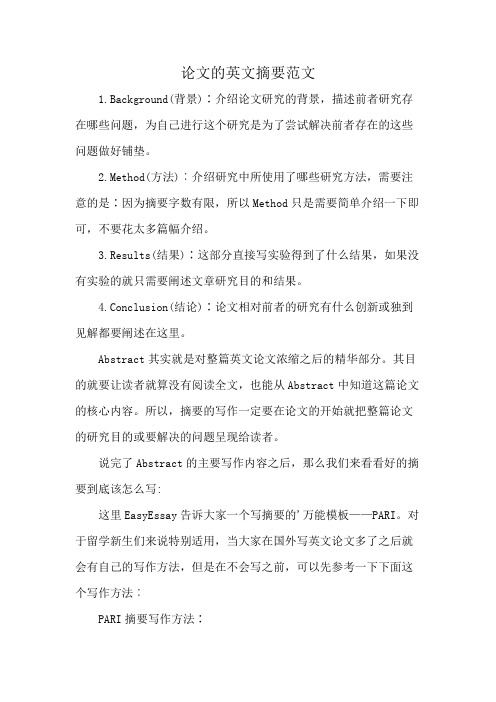
论文的英文摘要范文
1.Background(背景)∶介绍论文研究的背景,描述前者研究存在哪些问题,为自己进行这个研究是为了尝试解决前者存在的这些问题做好铺垫。
2.Method(方法)︰介绍研究中所使用了哪些研究方法,需要注意的是∶因为摘要字数有限,所以Method只是需要简单介绍一下即可,不要花太多篇幅介绍。
3.Results(结果)∶这部分直接写实验得到了什么结果,如果没有实验的就只需要阐述文章研究目的和结果。
4.Conclusion(结论)∶论文相对前者的研究有什么创新或独到见解都要阐述在这里。
Abstract其实就是对整篇英文论文浓缩之后的精华部分。
其目的就要让读者就算没有阅读全文,也能从Abstract中知道这篇论文的核心内容。
所以,摘要的写作一定要在论文的开始就把整篇论文的研究目的或要解决的问题呈现给读者。
说完了Abstract的主要写作内容之后,那么我们来看看好的摘要到底该怎么写:
这里EasyEssay告诉大家一个写摘要的'万能模板——PARI。
对于留学新生们来说特别适用,当大家在国外写英文论文多了之后就会有自己的写作方法,但是在不会写之前,可以先参考一下下面这个写作方法︰
PARI摘要写作方法∶
P=Problem:提出文章需要解决哪些问题
A=Approach:解决提出的问题是用的什么方法
R=Results:解决了提出的问题之后得到了什么结果l=lmpacts:这些结果有什么具体或者实际的影响。
本科毕业设计(论文)英文摘要及关键词模板
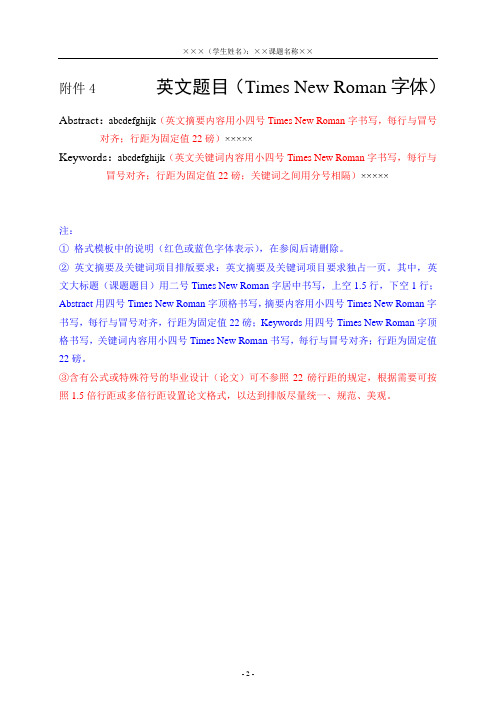
×××(学生姓名):××课题名称××
附件4 英文题目(Times New Roman字体)
Abstract:abcdefghijk(英文摘要内容用小四号Times New Roman字书写,每行与冒号对齐;行距为固定值22磅)×××××
Keywords:abcdefghijk(英文关键词内容用小四号Times New Roman字书写,每行与冒号对齐;行距为固定值22磅;关键词之间用分号相隔)×××××
注:
①格式模板中的说明(红色或蓝色字体表示),在参阅后请删除。
②英文摘要及关键词项目排版要求:英文摘要及关键词项目要求独占一页。
其中,英文大标题(课题题目)用二号Times New Roman字居中书写,上空1.5行,下空1行;Abstract用四号Times New Roman字顶格书写,摘要内容用小四号Times New Roman字书写,每行与冒号对齐,行距为固定值22磅;Keywords用四号Times New Roman字顶格书写,关键词内容用小四号Times New Roman书写,每行与冒号对齐;行距为固定值22磅。
③含有公式或特殊符号的毕业设计(论文)可不参照22磅行距的规定,根据需要可按照1.5倍行距或多倍行距设置论文格式,以达到排版尽量统一、规范、美观。
- 2 -。
2019年英文摘要的论文范文

英文摘要的论文范文有了英文摘要便方便了国际间的交流,取长补短,共同进步。
下面准备了几篇英文摘要的论文范文,欢迎欣赏!英文摘要的论文范文一Fortheviolationoflegitimaterightsandinterestsofconsumersava rietyofoffenses,howtoprovideforthecorrespondinglegalrespons ibilitiesandhowthelegalliabilitysystemreflectedthespecialpr otectionofconsumersshouldbe"ConsumerProtectionLaw"keysolved alegalissue.Tosolvethislegalproblem,itisnecessarytofurtherestablishareg ulatedmarketoperatingordertoprotectlegitimateinterestsofcon sumersandimprovingthelegalliabilitysystem.Ontheonehandistoestablishalegalsystemtheconceptofprotection ofconsumers;theotherhand,istoimproveconsumerprotectionlegalliabilitysys tem.对于侵犯消费者合法权益的各种违法行为,如何规定相应的法律责任以及在法律责任制度中如何体现对消费者的特别保护,应是《消费者权益保护法》重点解决好的一个法律问题。
要解决好这一法律性问题,就必须进一步建立起规范的市场经营秩序和完善保护消费者合法权益的法律责任制度。
一方面是建立消费者的法律体系保护观念;另一方面是完善消费者权益保护的法律责任制度。
英文摘要的论文范文二Titaniumore,electedfrommagiteorTitanmagite,iswidelyusedasth erawmaterialintheproductionoftitaniumdioxide.Titaniumqualit yanditsyieldconstraintsisoftenthebottleneckinthetitaniumind ustry.Thus,wecannotblindlyconsumealargeamountofcapitaltomaintaino rimproveitsqualityandyield.Thispapermakesanattempttoexplore sandoptimizethedevelopmentofthetitaniumindustry,throughinsi deandoutsideobservationandassociation.Inthispaper,flotation testsareconductedtoparetheoriginalpulptitaniumorewithPolyac rylamideandthatwithoutontheconcentrategradeyieldoftitaniumc oncentrates.Inthisprocess,theconsumptionofdrugs,therecoveryrateof,equip mentutilization,theamountandcostofpolyacrylamide(PAM)areall consideredtodeterminewhetheritisaptimizationprogramtoaddPol yacrylamidetotheoriginalflotationpulpoftitaniumore.Finally,wereachaconclusionthroughrelevantdata.Intheexperime ntalprocess,inprinciple,wedonotchangetheoriginalflotationprocessandtherelevantparam eters.Keywords:Titaniumore;Flotation;Polyacrylamide;quality;yield 英文摘要的论文范文三【ABSTRACT】Withthedeepeningoftheglobalization,newshasbeeanimportantpar tofinformationmunicationbetweendifferentcountries.WhetherEnglishnewstranslationisaccurateornotmaydirectlyaffe ctthequalityofourmunicationwithothercountries.InEnglishnews reportdiscourse,theuseofmetaphorexpressionsbeemoreandmore.DuetoEnglishnewsandotherstylisticdifferences,aswellastheEng lishandChineselanguages,ethnicdifferencesinideologyinthepro cessofcross-culturalmunication,makethetranslationofEnglishn ews,especiallyEnglishnewstranslationofmetaphorputforwardgreatch allengetotranslators.SohowtotranslatethemetaphorintheEnglis hnewsisthemutualconcernproblemfortranslationtheoristsandpra ctitionerstodiscuss,therefore,thispaperattemptstofromtheperspectiveofNida'sfunctionalequi valencetheorytodiscussthetranslationofmetaphorinEnglishnews .TheapplicationofmetaphorinEnglishnewsmakeseventsmoredistinc tandvivid,andalsomakeiteasierforEnglishreaderstoprehendandu nderstandthenewscontents.However,duetothedifferencesinEnglishandChineselanguages,the useofmetaphorsinEnglishnewsincreasesthedifficultyoftranslat ion.ThisarticleattemptsfromtheperspectiveofNida'sfunctionalequivalencetheorytodiscussthetranslationofmetaphorinEnglish news,inordertomakeChinesereadersbetterunderstandthesameresponsea ndsenseofbeautyandmeaningofmetaphorsinEnglishnewsastheorigi nalreaders.metaphorRhetoricisnotsimpleoftranslationintoChineseinEnglis hnewsfromtheliteraltransformation,althoughsomerhetoricorare totallythesameinformandcontent,whilethisisjustafew.ThereareculturaldifferencesinEnglishandChineselanguages,inf luencedbydifferentcultures.People'swayofthinkingandexpressi onhavedifferencesinevitably.Whenthetranslatorshouldfirstlyc onsciouslypondertheintentionoftheauthor,digthedeepmeaninghiddenbehindthemetaphorrhetoricofbackgroun d.Underthefunctionalequivalencetheoryregardthetranslatorast heguidance,conformtothelanguagehabitsofthetargetlanguagerea ders,makeChinesereaderscanbetterunderstandthetranslationofm etaphorinEnglishnews.KEYWORD:Englishnews;metaphor;functionalequivalencetheory;translation【中文摘要】随着全球化的深入,新闻成为不同国家之间交流的重要部分。
最强大的英文论文摘要模板句子 Abstract Appendix
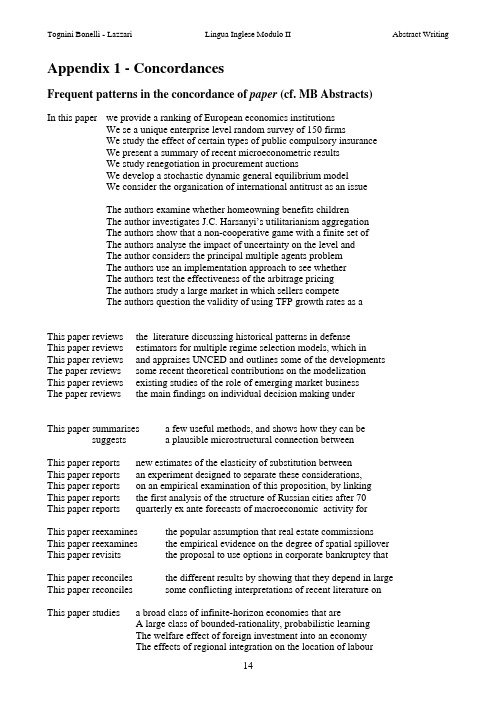
Appendix 1 - ConcordancesFrequent patterns in the concordance of paper (cf. MB Abstracts)In this paper we provide a ranking of European economics institutionsWe se a unique enterprise level random survey of 150 firmsWe study the effect of certain types of public compulsory insuranceWe present a summary of recent microeconometric resultsWe study renegotiation in procurement auctionsWe develop a stochastic dynamic general equilibrium modelWe consider the organisation of international antitrust as an issueThe authors examine whether homeowning benefits childrenThe author investigates J.C. Harsanyi’s utilitarianism aggregationThe authors show that a non-cooperative game with a finite set ofThe authors analyse the impact of uncertainty on the level andThe author considers the principal multiple agents problemThe authors use an implementation approach to see whetherThe authors test the effectiveness of the arbitrage pricingThe authors study a large market in which sellers competeThe authors question the validity of using TFP growth rates as aThis paper reviews the literature discussing historical patterns in defenseThis paper reviews estimators for multiple regime selection models, which inThis paper reviews and appraises UNCED and outlines some of the developments The paper reviews some recent theoretical contributions on the modelizationThis paper reviews existing studies of the role of emerging market businessThe paper reviews the main findings on individual decision making underThis paper summarises a few useful methods, and shows how they can be suggests a plausible microstructural connection betweenThis paper reports new estimates of the elasticity of substitution betweenThis paper reports an experiment designed to separate these considerations,This paper reports on an empirical examination of this proposition, by linking This paper reports the first analysis of the structure of Russian cities after 70This paper reports quarterly ex ante forecasts of macroeconomic activity forThis paper reexamines the popular assumption that real estate commissions This paper reexamines the empirical evidence on the degree of spatial spillover This paper revisits the proposal to use options in corporate bankruptcy thatThis paper reconciles the different results by showing that they depend in large This paper reconciles some conflicting interpretations of recent literature onThis paper studies a broad class of infinite-horizon economies that areA large class of bounded-rationality, probabilistic learningThe welfare effect of foreign investment into an economyThe effects of regional integration on the location of labourThe simplest formulation of the general screening modelThree price-based policies for solid waste reduction: (1)The impact of profit sharing and bonus payment onThe relationship between the degree of regional integrationWhether the price charged to a competitor for the use ofThe provision of environmental quality inThe intertemporal allocation of funds through demandThe implications of buyer’s liquidity constraintsCoverage extension in a simple general equilibrium modelthe paper shows that integration may turn an honest country into an evadingThis paper shows how the model can be solved and the optimal escape clauseThis paper shows generic determinacy of equilibria for sender-receiver cheap-This paper shows that if, the consumption good production function is alpha-this paper shows that it can be characterized in terms of restrictions on playThis paper shows that asymmetric information between lenders and borrowerThis paper shows that additive purchasing power parity (PPP) methods, suchThis paper starts by discussing the goals that should guide the design ofThis paper uses a dynamic agency model to offer a resolution of theA precise formalism to state and prove the following result:Census evidence from mid-nineteenth century France to investi-Uses the Panel Study of Income Dynamics to provide some ofA simultaneous model of census tract population and employmentFirm level date to examine the effectiveness of agreementsThis paper provides a motivation for public involvement in internal improvement This paper provides evidence that the common factor restrictions (CFR) playthis paper provides an introduction and overview on the economics of international This paper provides a utility-theoretic interpretation of "Don't-Know" (DK)This paper provides an axiomatic basis for a representation of personal preferThe paper provides a theoretical insight into the causes of a recession and aThis paper provides a theoretical model of waste management which is dynamicThis paper provides a theory of diversification and financial structure of banksThis paper provides a simple model to discuss the financing of networkThe paper proposes a new method for computing these probabilities, andThis paper proposes a signaling model that offers a new perspective on whyThis paper proposes a conceptual framework to investigate the effects ofThis paper presents an approach to such multilateral bargaining problems. AThis paper presents a model of the beef sector of the Greek economy.The paper presents an overview of state trading activities in Russia in light ofThe paper presents a new social accounting matrix (SAM) for Argentina andThis paper presents a data system that gives consistent, complete and detailedThis paper presents a general equilibrium model of a multi-city economy whereThe paper presents a model which allows identification of long-run responseThis paper presents a simple game-theoretic model in which players decideThis paper presents new evidence concerning the importance of poor relief asThis paper presents the first attempt to explore recent changes in office-comThe following paper presents a simple neoclassical growth model where corruption isThis paper presents an amenity-based theory of location by income.This paper presents the results of a political stock market in the NetherlandsThis paper presents a simple model of the links between education, democracyThis paper presents an extension of the Alesina and Drazen (1991. AmericanThis paper offers a model of the allocation of funds in Chinese state-ownedthe paper offers insights into the transition from a socialist economy into aThe paper offers a refined version of the procedure, and it also responds toThis paper offers a counter-argument to Friedman's (In: Essays in PositiveThis paper offers a short survey of recent contributions about the information-This paper offers an alternative analysis that relates voting outcomes to theThe main conclusion of the paper is that the Italian depression, comparable to that of other The main finding of the paper is that the desirability of an electoral area between twoThe hypothesis examined in this paper is that the greater the investor's flexibility, the easier it is forThe aim of this paper is to evaluate whether structural change is a key element in accoThe contribution of this paper is to identify the presence of a profit-sharing system and an infor The purpose of this paper is to consider what determines the differences between the combi The purpose of this paper is to consider the effect of the composition of economic activity o The objective of this paper is threefold. First, to estimate the productivity performances realizA further distinguishing aspect of the paper is its attempt to incorporate the impact of unobservableThe purpose of the paper is to reconcile the willingness to pay technique as a means of coll The novelty of this paper is twofold. First, it defines a range of competition policy implemen The purpose of this paper is to assess the importance of spatial variability in physical param The aim of this paper is to construct theoretical models which help to shed light on theThe purpose of this paper is to explain empirical observations concerning the impact of exch The objective of this paper is to use input-output analysis to examine the resource allocation This paper investigates the empirical significance of underwriter reputation caThis paper investigates the knowledge that people have of the spatial distribuThe paper investigates one aspect of party governance, namely the allocatioThis paper investigates the relationship between agglomeration and specializThis paper investigates the impact on company behaviour of increases in finaThe paper investigates the optimal provision of public goods in the presenceThis paper investigates institutional reasons for the soft-budget constraint proThis paper investigates convergence for a group of seven countries during theThe paper investigates the impact of financial integration on asset return, risThis paper explores the possibility of using the classical concept of 'civil sociThis paper explores the hypothesis that high tax rates can distort the decisioThis paper explores two sets of potential determinants of this decision. Onethis paper explores the connections between the distribution of land, factorThis paper explores some relationships between promotion of competition anThe paper explains why bank loans and grants coexist with self-financing, wThis paper examines the effect of the MFC rules adopted by Medicaid on botThis paper examines the quantitative effects of the transitional system of valueThis paper examines the intertemporal optimal consumption and investment This paper examines an evolutionary model in which the primary source of This paper examines the access of small private-sector firms in Hungary toThis paper examines the relationship between community-level exposure to a This paper examines issues that senior human resource management execuThe paper examines a local public goods economy where individuals' tastes This paper examines the effects of age, occupation, population size of place The paper examines a large population analog of fictitious play in which play This paper examines how profit maximizing fishers respond to different types This paper examines incentive and valuation effects of debt financing on land This paper examines some general notions relating to the comparison of Cou This paper examines how a public wastewater treatment plant balances obje This paper examines the empirical validity of this explanation using data on o this paper examines to what extent licence contracts can internalize the bus This paper examines the impact of the various reform measures on the produ This paper examines the hypothesis of Harold Innis (1894¯1952) that there is this paper examines the roles of transportation policy and demographic chan This paper examines the spatial evolution of computers across 317 metro are This paper examines the implications of tax evasion for fiscal competition an This paper examines the argument that the availability of collateral rules out This paper examines the effects on technology transfer and spillovers derivin This paper examines the consequences of falling transport costs for intermed This paper examines the evolution of the role of income distribution in the pro This paper examines how the presence of a non-negligible fraction of reciproc This paper discusses some analytical and practical questions raised by MCI This paper discusses the structure of the individual AMT and examines the lo This short paper discusses recent insights of multitask agency theory. It considers The paper discusses the history of the plans beginning in the Soviet period, t This paper discusses some problems posed by foreign currency debt for em This paper develops an estimable model of recreation behavior in which the r This paper develops an econometric model that incorporates all three compo the paper develops a housing search model and measures the cost of discri This paper develops a general-equilibrium model of a system of core-peripher This paper develops a positive theory explaining pollution tax policy outcome This paper develops a model of price determination in insurance markets. Ins The paper develops conditions under which clusters of activity emerge. Auth This paper develops an analytical framework to assess these effects. Circum This paper develops a model of regulated open access resource exploitation. This paper develops and discusses a two-sector general equilibrium growth This paper develops a model of corporate hierarchy in which workers accumu This paper develops a model of the choice between bank and market finance This paper develops a dynamically consistent model of search, matching and This paper develops a particular technique for extracting market expectations This paper develops an interpretation of the Asian meltdown focused on mora This paper develops a model of an unregulated banking system based around This paper deals with t he problem by specifying an endogenous regime-switch This paper deals with c ompany expectations for l997 with regard to employment this paper deals with those two issues. It will be argued in favour of an anti-infThis paper considers how cooperative solutions to games of sharing fish reso This paper considers the 'weak announcement proofness' criterion of S. A. M the paper considers dynamic allocation in an altruistic overlapping generatio This paper considers model worlds in which there is a continuum of individual this paper considers Australia's post-July 1997 regulatory regime for telecom The paper considers international per capita output and its growth using a pa This paper considers the optimal selling mechanism for complementary item The paper considers economic processes that may lead to the consolidation This paper considers a school choice plan, open enrollment, that allows stud This paper considers interjurisdictional tax competition in a two-period model This paper considers the implications of the decision of the Australian Industr This paper considers a smooth and noisy version of the statistical prediction This paper considers a fixed normal-form game played among populations of This paper considers why firms often ban monetary exchange between their This paper considers bidding behavior in a repeated procurement auction sett The paper concludes by examining welfare issues. This paper examines ho The paper concludes by explaining the relationship between the options appr This paper compares Bertrand and Cournot equilibria in a differentiated duopo This paper compares four equilibrium business cycle models with increasing This paper compares the two societies which have encouraged the study of e This paper combines statistical with economic equilibrium analysis in the co This paper attempts to show how the International Bank for Reconstruction a This paper attempts an analysis of the impact of migration on the scale and The paper attempts to reconcile some views on the Piccione-Rubinstein abs This paper argues that the analysis of these games involves a key technical i This paper argues that successful states in the ancient world depended on th This paper argues that while both technological opportunity and appropriabilit This paper argues that the way fiscal redistribution has managed to countera This paper argues that the sign of external effects of coalition formation provi The paper argues that in centrist parties, the high congruence of interest bet This paper argues that risk is related to long-run volatility of income and there This paper argues that the liberalisation of foreign direct investment (FDI) has This paper argues that unemployment insurance increases labor productivity This paper analyzes competitive allocations of an exhaustible resource in an the paper analyzes the role of crises and foreign assistance in bringing abo The paper analyzes the highlights of the country's economic recovery, explor The paper analyzes the effects of central bank independence on the position The paper analyzes a simple discrete-time noncooperative coalititional barga This paper analyzes the formation of trading groups in a bilateral market wher This paper analyzes repeated games with private monitoring where in each p This paper analyzes the relationship between unemployment duration and th This paper analyzes D. Pearce's (1984) notion of extensive form rationalizabil This paper analyzes the theory that Soviet farm marketing was so price unre The paper analyzes the institutional conditions under which policymakers ca This paper analyzes the effects of information on participation and time-of-usThis paper analyzes the deadweight loss of delegated auditing in a three-tierThis paper analyzes the deadweight loss of delegated auditing in a three-tierThis paper analyzes the optimal interest rate policy in currency crises. FirmsThe paper analyses the welfare effects of these taxes as well as to what extThis paper analyses the employment effects of revenue-neutral green tax refo. This paper analyses the impact of modifying this assumption by allowing forThe paper analyses the switch from pay-as-you-go to funded pensions ¯ penThis paper analyses the decision by firms under Cournot oligopoly as to recoThis paper analyses the factors determining the scale and location of Japanethis paper addresses the effect of rent control laws on two groups considereIn addition, the paper addresses the effects of open enrollment on competition betweenthis paper addresses the formalization and implications of the hypothesis thThis paper addresses two general questions. First, what is the effect of markPurposeThe purpose of this paper is to consider what determines the differences between the combinations of financial and labour systems observed in some large market economies. The purpose of this paper is to consider the effect of the composition of economic activity on innovation.The purpose of this article is to explain the major changes made by the Basle Committee to its previous set of proposals (Basle Committee 1995) which were outlined in Hall 1995. The purpose of the paper is to reconcile the willingness to pay technique as a means of collecting information, put forward in earlier studies, with the growth theoretical approachto social acThe purpose of this study is to compare the performance of the public sector with that of the private sector for the various sub-sectors of manufacturing in Turkey. The purpose of this paper is to assess the importance of spatial variability in physical parameters in the design of efficient pollution regulations. The purpose of this paper is to explain empirical observations concerning the impact of exchange rate changes on industrial prices.Framework1 The optimum currency area analysis is reexamined in a Mundell¯Fleming framework withlocal-currency pricing.2 The authors consider Amartya Sen's familiar paradox of the Paretian liberal in a frameworkwhere individual rights are represented as a game form.3 Using a three-period framework, we provide approximate solutions for optimal consumptionchoices4 This paper proposes a conceptual framework to investigate the effects of central bankindependence, of the degree of centralization of wage bargaining and of the interaction betweenthose institutional variables, on real wages, unemployment and inflation,5 The present paper extends the standard framework to cover the case of labour-augmentingtechnological progress.6 This paper develops an analytical framework to assess these effects.7 This paper applies this framework to an exchange-rate escape clause but is unable to solvehis model given a triangular distribution of the supply shocks.8 In order to understand how self-fulfillment can be realized in a dynamic framework, theauthors investigate the relationship between9 Using this bargaining framework, the paper analyzes the role of crises and foreign assistancein bringing about a settlement to the distributional conflict.10 Nonconvexities are not fundamental in this framework.11 We use a framework that nests an increasing returns model of economic geography featuringhome market effects' with that of Heckscher¯Ohlin.12 We introduce a framework that has known models of oligopolistic competition withdifferentiated products (the circle, the logit, and the CES) as limit cases.13 the pros and cons of these different approaches within a coherent conceptual framework thatapplies contract theory to the regulation of banking.14 Conversely, it is shown in a general framework that any convex (thus progressive) taxfunction satisfies the principle of equal sacrifice.15 o show that the most important predictions of the standard theory hold in the general finiteframework studied here.16 In this framework, prescription drug discounts appear to make some consumers (those in themanaged care sector) better off and other consumers (those outside the managed care sector)worse off.17 This paper analyzes the theory that Soviet farm marketing was so price unresponsive that rapidindustrialization within the framework of the NEP would have been choked off by rising farm prices and inadequate sales.18 We first point out that the current framework of public international law allows for widediscretion in the assertion of jurisdiction.19 The analysis is carried out in the framework of a general equilibrium model of a mixedeconomy with production.20 We find that in this framework, much of the scope for conflict disappears.21 Although seldom modeled outside the monopolistic competition framework, marketincompleteness and imperfect competition are central to the new growth theories.22 A simple game-theoretic framework is applied to analyse international cooperation byfocusing on the prisoner's dilemma on the one hand and bargaining in the Coasian sense on theother.23 The model provides a simple theoretical framework in which the level of corruption as well asthe effects of corruption on income, consumption, and growth are identifiable.24 This is modeled in the context of a political economy framework in which social cohesionreduces wasteful rent seeking, and thus strengthens incentives for investment in human captial.25 recently demonstrated a potential conflict between stability and efficiency in this framework.26 Based on the principal¯agent framework I develop a simple model of policy loans, which aregranted by the government on non-market terms, to formalize this important bankingphenomenon in both China and other developing countries.27 The model serves as the framework for an econometric study of participation in theConservation Reserve Program by Northeastern landowners.28 In the absence of an institutional framework facilitating more dispersed ownership,29 Studies of optimal growth in a multisector framework are generally addressed in reduced-form models, defined by an indirect utility function which summarizes the consumer'spreferences and the technologies.30 Instead, an incentive framework and legal environment should be created for the majornongovernment creditors to initiate restructuring.31 The authors develop this conceptual framework and assess the findings from three studies ofmajor commercial banks undergoing privatisationResult in (Vb)1 Ruggiero et al- (1997) argue that the 'Pythagorean Theorem' is an inappropriate basis forevaluating baseball managers and has an illogical arithmetic property that can result in amanager's evaluation being dependent upon the strength of his team.2 Olewiler (1993 and 1995) describe a model in which some competition can result insuboptimal Nash equilibrium.3 Rather, they may result in the formation of a megalopolis that consists of large core cities thatare connected by an industrial belt, i.e., a continuum of cities, where economic activities aredispersed over an interval on the location space.4 Violation of (ii) may result in cyclical behaviour of actions on each sample path.5 Violation of (i) may result in an 'anything is possible' result: any stochastic process of actions isconsistent with maximizing behaviour and Bayesian updating.6 and how the soft-budget constraint problem creates conditions which may result in a financialcrisis.7 empirical finding suggests that the missing common factor restrictions may result in a quitedifferent and perhaps misleading inference.8 In our benchmark, small reductions in working time, starting from the laissez-faire equilibriumsolution, always result in a small increase in the equilibrium employment, while largerreductions reduce employment.9 a one unit increase in (subsidized) free parking will result in more than one additional parker,adding to neighbourhood spillovers.10 says that the Board believes that this bill would improve the efficiency and competitiveness ofthe financial services industry and result in better service to consumers11 programs converge to a fixed point or to a cycle of finite period, and hence result in theconservation of the resource.As a result1 some of these payments are made purely as a result of asymmetry in bargaining power and havenothing to do with2 increased parcel sizes would be associated with lower unit prices as a result of the concavity ofthe land price function.3 1.8 million defense-related jobs in the private sector would be lost as a result of the actual andproposed cuts in spending4 yields the corresponding consistent bankruptcy rule as a result of a unique outcome of Nashequilibria.5 As a result, international bodies such as the EU, ITU, OECD and WTO are6 As a result, his finding undermines the credibility of the existing conclusion7 As a result, Geary¯Khamis comparisons tend to underestimateResult (N)1 The main result states that if the payoff functions are semicontinuous and strong2 The main result of this study is that a financial constraint may serve as a discipli3 The main result obtained from the simulation of the theoretical model is that, alt4 The main result is that regional integration, in the form of a reduction in transport5 The main result is that if we take a certain order is greater than or equal to6 The main result is convergence with probability one to a fixed pattern of pure7 This result is consistent with suggestions that agricultural districts where t8 This result is obtained by using martingale techniques to reformulate the in9 This result is applied to game theory to obtain a natural interpretation of co10 This result is shown to be consistent with available evidence on working11 This result has implications for empirical work. Moreover, this negative effect13 However, the fundamental reason for this result has nothing to do with vintages; rather,14 This result follows the presumption that women are poorly motivated by15 An example shows that this result does not carry over to stationary stochastic environments.16 Their result is robust to a variety of specification tests. Using panel data15The importance of the result is exemplified by the graduate tax.16The result holds for a large class of consistent and monotone rules, including17The result does not come from an effect of instability on investment.Evidence1. New evidence is presented that reaffirms the predominance of local-currency pricing2. Evidence is found of local spatial externalities between university research and3. Evidence is presented that it was the Ford Motor Company that first develope4. Evidence is presented showing that job-finding probabilities of the unemployed5. First, detailed historical evidence is studied. Second, Innis's ideas are translated into aformal6. Evidence is lacking on the extent to which groups facilitate rent-seeking or7. Evidence is then presented showing that inflation is positively correlated with8. Evidence is also lacking on the extent to which groups hamper the future deve9. Furthermore, quantitative evidence is presented supporting the view that Federal Reserve10. Empirical evidence is found in favour of a stable long-run M2 money demand function11. Evidence from the French experience Thomas Piketty* CEPREMAP, 142 ru12. It provides evidence from British and German data that is consistent with this view.13. Evidence from industrial and developing countries: Francesco Giavazzi,14. This paper uses census evidence from mid-nineteenth century France to investigate howand to15. Insider power and wage setting in transition: Evidence from a panel of large Polish firms,16. The effects of wage distortions on the transition: Theory and evidence from China RogerH.17. Our evidence supports the finding that the social security system has substantially18. The evidence suggests that migration between industry and agriculture was quite19. I then argue that the existing evidence suggests that the performance effects of groupaffiliation20. The evidence suggests that five price series exhibit stochastic trends, while the21. Empirical evidence strongly supports this finding for industrialized countries and Europe22. Evidence shows that firms build their market position by accumulating knowledge23. However, other evidence shows that general training is financed by firms, especially in24. The evidence provides considerable support for the diversity thesis but little support25. The evidence provides ways for the People's Bank of China to improve the effective26. There exists evidence of a sizable shift of elderly households away from homeownership.27. The author finds strong evidence of MAR (Marshall-arrow-Romer) (own industry, orlocalization)28. The model is consistent with the empirical evidence of SOEs restructuring in transition29. We find strong evidence of significant dynamic own industry externalities for single plantfirm30. Evidence of superior forecasting skill would imply that U.S. monetary authorities31. found to provide strong evidence of local spillovers at the state level. At the MSA level, a32. and little evidence of urbanization-Jacobs-knowledge type externalities. Corporate plant。
论文写作中的英文摘要范例
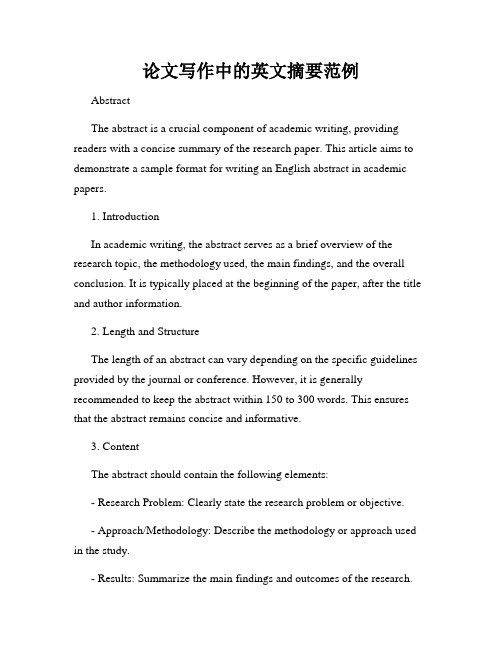
论文写作中的英文摘要范例AbstractThe abstract is a crucial component of academic writing, providing readers with a concise summary of the research paper. This article aims to demonstrate a sample format for writing an English abstract in academic papers.1. IntroductionIn academic writing, the abstract serves as a brief overview of the research topic, the methodology used, the main findings, and the overall conclusion. It is typically placed at the beginning of the paper, after the title and author information.2. Length and StructureThe length of an abstract can vary depending on the specific guidelines provided by the journal or conference. However, it is generally recommended to keep the abstract within 150 to 300 words. This ensures that the abstract remains concise and informative.3. ContentThe abstract should contain the following elements:- Research Problem: Clearly state the research problem or objective.- Approach/Methodology: Describe the methodology or approach used in the study.- Results: Summarize the main findings and outcomes of the research.- Conclusion: Present the key conclusions or implications of the study.4. Language and Style- Clear and Concise: Use clear and concise language to convey the main points of the research.- Avoid Abbreviations and Jargon: Use full terms instead of abbreviations, unless they are widely recognized.- Past Tense: Write the abstract in the past tense since the research has already been conducted.- Third Person: Write the abstract in the third person, using objective language.5. Example[The following is a fictional example of an abstract for a research paper on climate change.]Title: The Impact of Climate Change on Biodiversity in Tropical RainforestsAbstract:This research aims to investigate the impact of climate change on the biodiversity of tropical rainforests. The study utilized a combination of field surveys, satellite imagery analysis, and statistical modeling to assess changes in species diversity, habitat loss, and ecosystem stability. The results indicated a significant decline in species richness, increased habitat fragmentation, and heightened vulnerability of endemic species to climate-related events. These findings have important implications for conservationstrategies and the management of biodiversity hotspots in the face of climate change. By understanding the effects of climate change on tropical rainforests, policymakers can develop more targeted approaches to mitigate its impact and ensure the long-term survival of these vital ecosystems.6. ConclusionIn conclusion, writing an effective English abstract is crucial for an academic paper as it provides readers with a concise overview of the research. Following the recommended format and guidelines can help researchers communicate their findings accurately and succinctly. By adhering to the suggested structure and style, authors can ensure their abstracts are informative and engaging for readers.。
科技论文英文摘要模板

科技论文英文摘要模板篇一:论文英文摘要格式重庆科技学院高等教育自学考试本科毕业论文英文摘要宋体五号The Title of the thesis空一行ABSTRACT Times New Roman三号加粗,居中空一行Due to lack of effective ways to utilize the bottom ashes of circulating fluidized bed combustion (CFB ashes), it is difficult to use widely the advanced technology of circulating fluidized bed combustion and defulfurization. In this paper, the properties of the CFB ashes are systematically analyzed and then a series of methods are proposed to evaluate the reactivity of CFB ashes. Meanwhile, the factors influencing and the method activating the reactivity of CFB ashes, and the expansion properties are investigated experimentally. The spontaneous setting, and the mechanism of activation of reactivity of CFB ashes and its expansion are investigated by XRD and SEM. Finally, the utilization in building materialsof CFB ashes is studied.The properties of CFB ashes show it is difficult to utilize CFB ashes in building materials, however reasonable using its properties is possible in building materials. As concrete fine aggregate, it can improve structure of interface between aggregates and cement paste for its reactivity, then can increase the concrete flexural strength. As concrete additive can fully activate the reactivity, and can partly compensate the concrete shrinkage. Because of performance of the fresh concrete and durability, it is better to use it with FA. They both influence performance of the fresh concrete. It can produce CFB ashes-fly ash mortar used indoors and CFB ashes-fly ash-clinker mortar used outdoors with low shrinkage by using the cement and expansion of CFB ashes. CFB ashes mixed with lime, FA or cement, can be used for roadbed mixture in road Times New Roman小四号Keywords:Circulating Fluidized Bed Combustion, CFB Ashes, Reactivity, Expansion,Times New Rom小四号Times New Roman加粗小四号Ⅱ篇二:科技论文英文摘要的编写及翻译科技论文英文摘要的编写及翻译随着科学技术的日新月异,我国在科技领域取得了越来越多的成就,受到更多国际同行的关注。
本科毕业论文英文摘要怎么写

本科毕业论文英文摘要怎么写Writing an Abstract for an Undergraduate ThesisAbstracts are concise summaries of research papers or academic articles that provide a brief overview of the study's purpose, methods, results, and conclusions. They serve as a standalone text and enable readers to quickly understand the main points of the paper without having to read the entire document. This article aims to guide undergraduate students on how to write an effective abstract for their thesis.1. IntroductionThe abstract section is a vital component of any research paper. It should accurately represent the content of the thesis, enticing readers to continue reading. When crafting an abstract, it is essential to consider its length, organization, and the specific elements to include.2. Content of the AbstractTo ensure a comprehensive and accurate summary, an abstract should typically include the following elements:2.1. Background and Purpose: Briefly explain the context of the research and state the objectives or questions addressed in the study. Highlight the significance of the research topic and its relevance to the field.2.2. Methodology: Describe the research approach, including the study design, data collection methods, and analysis techniques employed. Mention any specific tools, software, or equipment used.2.3. Results: Summarize the main findings of your research. Provide the key quantitative or qualitative results obtained and emphasize their significance. Avoid including excessive details or statistical analyses.2.4. Conclusion: State the main conclusions drawn from the study. Highlight the implications of the findings and their potential impact on the research field or practical applications.3. Structure and FormattingTo ensure clarity and conciseness, follow these guidelines when structuring your abstract:3.1. Length: Typically, undergraduate thesis abstracts range from 150 to 350 words. Check if your university or department has specified any word limit requirements.3.2. Language and Tone: Use clear and straightforward language to convey your research effectively. Avoid jargon, abbreviations, or technical terms that may be unfamiliar to a broad audience. Maintain an objective tone throughout the abstract.3.3. Organization: Arrange the content logically and coherently. Start with an introduction, followed by the methodology, results, and conclusion sections. Consider the specific requirements of your discipline or department.3.4. Grammar and Style: Ensure proper grammar, punctuation, and sentence structure. Use active voice and past tense to describe the research conducted and results obtained.4. Seeking Feedback and RevisionsAfter drafting your abstract, seek feedback from your advisor, professors, or peers. Incorporate any suggested revisions to enhance theclarity, accuracy, and overall quality of your abstract. Pay attention to word choice, grammar, and the appropriateness of the content.5. Checking for Accuracy and ClarityBefore finalizing the abstract, carefully review it to ensure its accuracy and clarity. Verify that the content provided aligns with your thesis, and all necessary details are included. Focus on maintaining a concise yet informative summary.6. ConclusionThe abstract serves as a condensed version of your undergraduate thesis, making it essential to capture the main points effectively. By adhering to the guidelines outlined above, you can write a clear, concise, and accurate abstract that provides readers with a comprehensive overview of your research. Remember, mastering the art of writing an abstract is crucial not only for your undergraduate thesis but also for future research endeavors.。
英文作文开头摘要

英文作文开头摘要英文,As I sat down to write this essay, I couldn't help but think about how important it is to be able to communicate in different languages. Being bilingual has opened up so many opportunities for me, both personally and professionally. 。
I remember a time when I was traveling in China and I was able to navigate my way around the city and have conversations with locals in their native language. It made me feel more connected to the culture and the people, and I was able to learn so much more than if I had only been able to speak English. 。
Being able to speak multiple languages has also helped me in my career. I work for a global company, and being able to communicate with colleagues and clients from different countries has been a huge advantage. It has allowed me to build stronger relationships and has given me a deeper understanding of different perspectives and waysof doing business.中文,当我坐下来写这篇文章的时候,我不禁想到能够用不同的语言交流是多么重要。
天津大学毕业论文 中英文摘要模板

附件:
[论文中文题目(楷体GB2312,加粗,四号字,取中)]
学生姓名:学号:学科专业:
指导教师:入学时间:答辩时间:
论文摘要:(宋体,加粗,五号字,单倍行距)
[摘要内容,800-1000字,宋体,五号字,单倍行距]
关键词:[不多于5个,宋体,五号字,单倍行距]
[论文英文题目(Times New Roman,加粗,四号字,取中)] Candidate:Supervisor:
Major:
Abstract:
(内容Times New Roman,小四号字,单倍行距)
Key words:
攻读学位期间公开发表的论文和获得的专利:
[论文作者、论文名称、刊物名称.卷(期):起止页码.年、月,SCIE/EI检索号,SCIE分区;宋体,五号字,单倍行距]
(注:论文的中英文摘要必须正反打印在A4纸上)。
论文英文摘要范文
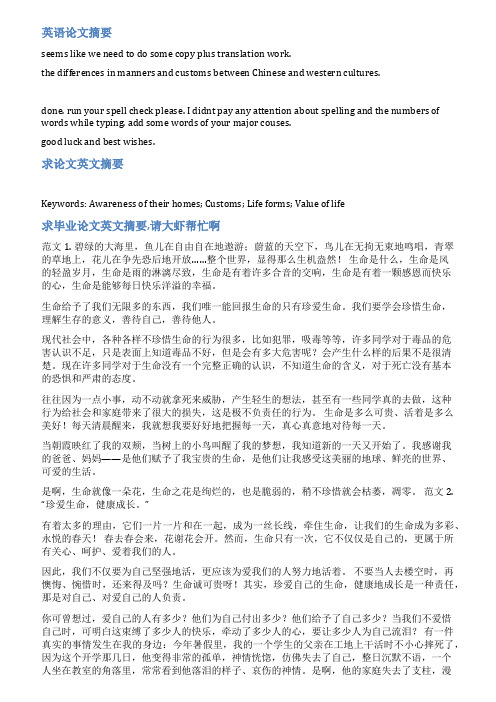
英语论文摘要seems like we need to do some copy plus translation work.the differences in manners and customs between Chinese and western cultures.done. run your spell check please. I didnt pay any attention about spelling and the numbers of words while typing. add some words of your major couses.good luck and best wishes.求论文英文摘要Keywords: Awareness of their homes; Customs; Life forms; Value of life求毕业论文英文摘要,请大虾帮忙啊范文1. 碧绿的大海里,鱼儿在自由自在地遨游;蔚蓝的天空下,鸟儿在无拘无束地鸣唱,青翠的草地上,花儿在争先恐后地开放……整个世界,显得那么生机盎然!生命是什么,生命是风的轻盈岁月,生命是雨的淋漓尽致,生命是有着许多合音的交响,生命是有着一颗感恩而快乐的心,生命是能够每日快乐洋溢的幸福。
生命给予了我们无限多的东西,我们唯一能回报生命的只有珍爱生命。
我们要学会珍惜生命,理解生存的意义,善待自己,善待他人。
现代社会中,各种各样不珍惜生命的行为很多,比如犯罪,吸毒等等,许多同学对于毒品的危害认识不足,只是表面上知道毒品不好,但是会有多大危害呢?会产生什么样的后果不是很清楚。
现在许多同学对于生命没有一个完整正确的认识,不知道生命的含义,对于死亡没有基本的恐惧和严肃的态度。
往往因为一点小事,动不动就拿死来威胁,产生轻生的想法,甚至有一些同学真的去做,这种行为给社会和家庭带来了很大的损失,这是极不负责任的行为。
- 1、下载文档前请自行甄别文档内容的完整性,平台不提供额外的编辑、内容补充、找答案等附加服务。
- 2、"仅部分预览"的文档,不可在线预览部分如存在完整性等问题,可反馈申请退款(可完整预览的文档不适用该条件!)。
- 3、如文档侵犯您的权益,请联系客服反馈,我们会尽快为您处理(人工客服工作时间:9:00-18:30)。
In the lotus root-shape channels, the flow takes on an obviously 3-D turbulent characteristics, as the river has changed suddenly and the shoreline has inflected. So, the turbulence intensity in the lotus root-shape channels is much greater, compared with the straight channels. As the flow characteristics, including flow resistance, stage-discharge relationship, waterline, transverse slope of water surface, flow velocity distribution and turbulence characteristics etc, is bound up with the environmental protection, the general navigation, the flood protection and the power systems, so it is one of the most fundamental problems in hydraulics and river dynamics. Many researches have been carried out on the flow characteristics about the straight channels or the meandering river channels. Yet the flow movement disciplines of the lotus root-shape channels have got little achievement.
Nowadays, turbulent models have been widely adopted in fluid computation, with the ε-k model being the most popular for its high efficiency and precision. However, the independent similar turbulent assumption makes it limited in the adoption of complex flow, which makes the distinct Reynolds stress model competitive.
Under the foundation of systematically conclusion of the research result of the lotus root-shape channels flow characteristics at home and abroad, this dissertation will source, arrange and analyze the present test material to take mock calculation of the continuous curve flow and compare with the measured value to testify the advantage and disadvantage of all the models using the three ε-k models and Reynolds stress model supplied by software Fluent. Through the contrast of 3D flow numerical simulation in the straight channels and the lotus root-shape channels, the paper reveals the methodology of turbulent fluctuation, energy loss and flow resistance influenced by the lotus root-shape channels. The main research content and result are as follows:
1) The paper makes detailed introduction about the variance and solving of curve flow model theory and equation, the calculation of Fluent software.
2) The paper in chapter three uses the three-dimensional standard ε-k model, RNG ε-k model, Realizable ε-k model and Reynolds stress model, disperses the turbulent flow with the finite volume method and brings in the VOF method to trace
free surface, PISO method to calculate the pressure and velocity pattern, to statistically simulate the consecutive-bend flow and get the pattern of water surface curve, flow velocity, circulation structure and turbulent characteristics, compare with the practical test to analyze the accuracy of different models to get the characteristic of curve flow movement effect better with the Reynolds stress model than the other three ε
k model.
-
3)The paper in chapter four uses the Reynolds stress model to give further calculation of straight channel which has the equal length and same cross section in geometry with the lotus root-shape channels, then analyzes the related characteristic. Compared with the straight channels, the flow in the lotus root-shape channels is much more complex. In the lotus root-shape channels, the flow circulation and the turbulent fluctuation are stronger, namely more energy is transparent from water and dissipates through the viscosity force, and then the flow resistance increases.
4)Based on the portioning method, the basic concept of the cross-sectional form resistance is proposed. The additional resistance to flow caused by cross-sectional shape variation along the riser is called cross-sectional form resistance. Its value can be regarded as the difference between natural river resistance and the straight channel resistance whose length and cross-section are as same as the natural river. According to the numerical simulation results, the cross-sectional form resistance formula is obtained.
This paper presents a possible method to study the flow characteristics. Hope the related analysis and research in the paper can bring some light in the future study of the flow fluctuation and energy loss in hydraulics and river dynamics.
Key words: lotus root-shape channel flow, turbulent flow model, numerical simulation, cross-sectional form resistance。
